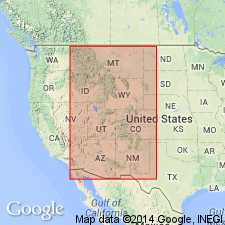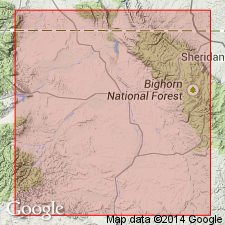
- Usage in publication:
-
- Wasatchian age
- Modifications:
-
- Original reference
- AAPG geologic province:
-
- Bighorn basin
- Wind River basin
Summary:
Pg. 10, pl. 1. Wasatchian age. Provincial time term, based on at least upper part of Wasatch group of southwestern Wyoming (modified to Wasatchian series by C.R. Keyes). Covers the time during which the faunas of the Sand Coulee, Gray Bull, Lysite, and Lost Cabin were deposited. As a functional term, the typical areas and faunas are those of the Bighorn and Wind River basins of Wyoming. Includes the interval between the Clarkforkian (Paleocene) and Bridgerian (Eocene) ages. [In lower part of Eocene; = HYRACOTHERIUM faunal zone.] Report defines 18 provincial time terms, based on mammal-bearing units, for the North American continental Tertiary. [For sequence see under Puercan.]
Source: US geologic names lexicon (USGS Bull. 1200, p. 4140).

- Usage in publication:
-
- Wasatchian land mammal age
- Modifications:
-
- Age modified
- AAPG geologic province:
-
- Bighorn basin
Summary:
Paleocene-Eocene boundary can be placed at the 100 m level above the base of the Willwood Formation and within the Wasatchian land mammal age at Elk Creek (T50N, Rs93 to 96W), Big Horn Co, WY in the Bighorn basin. Boundary placement is based on the first occurrence of the Eocene index pollen PLATYCARYA PLATYCARYOIDES. Below the 100 m level, the palynoflora is dominated by CARYAPOLLENITES VERIPITES and other taxa typical of the late Paleocene. Willwood also contains one of the most completely known sequences of Wasatchian mammal faunas. P. PLATYCARYOIDES occurs at or near the nannofossil NP9/NP10 (or Paleocene/Eocene) boundary at localities in SC, VA, AL, and CA. If P. PLATYCARYOIDES is a reliable fossil, the Willwood rocks below the 100 m level and in the lower part of the Wasatchian are Paleocene. Relationship of type Sparnacian Stage, the uppermost Paleocene of the Paris basin to the marine microfossils is uncertain. Most prefer to use the marine section rather than rely on correlation with the Paris basin.
Source: GNU records (USGS DDS-6; Denver GNULEX).
For more information, please contact Nancy Stamm, Geologic Names Committee Secretary.
Asterisk (*) indicates published by U.S. Geological Survey authors.
"No current usage" (†) implies that a name has been abandoned or has fallen into disuse. Former usage and, if known, replacement name given in parentheses ( ).
Slash (/) indicates name conflicts with nomenclatural guidelines (CSN, 1933; ACSN, 1961, 1970; NACSN, 1983, 2005, 2021). May be explained within brackets ([ ]).

